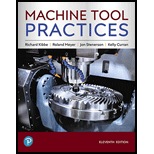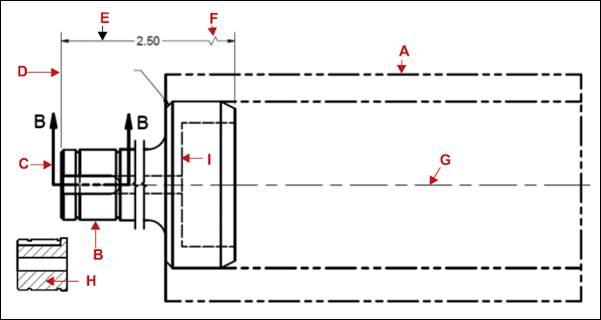
EBK MACHINE TOOL PRACTICES
11th Edition
ISBN: 9780134985824
Author: CURRAN
Publisher: VST
expand_more
expand_more
format_list_bulleted
Question
Chapter A.6, Problem 1ST
To determine
The nature of lines of the following figure.

Expert Solution & Answer
Want to see the full answer?
Check out a sample textbook solution
Students have asked these similar questions
Example-1:
l
D
A uniform rotor of length 0.6 m and diameter 0.4 m is made of steel (density 7810 kg/m³)
is supported by identical short bearings of stiffness 1 MN/m in the horizontal and vertical
directions. If the distance between the bearings is 0.7 m, determine the natural frequencies
and plot whirl speed map.
Solution:
B
find the laplace transform for the
flowing function
2(1-e)
Ans. F(s)=-
S
12)
k
0
Ans. F(s)=
k
s(1+e)
0 a
2a 3a 4a
13)
2+
Ans. F(s)=
1
s(1+e")
3
14) f(t)=1, 0
Find the solution of the following Differential Equations
Using Laplace Transforms
1) 4y+2y=0.
y(0)=2.
y'(0)=0.
2) y+w²y=0,
(0)=A,
y'(0)=B.
3) +2y-8y 0.
y(0)=1.
y'(0)-8.
4)-2-3y=0,
y(0)=1.
y'(0)=7.
5) y-ky'=0,
y(0)=2,
y'(0)=k.
6) y+ky'-2k²y=0,
y(0)=2,
y'(0) = 2k.
7) '+4y=0,
y(0)=2.8
8) y+y=17 sin(21),
y(0)=-1.
9) y-y-6y=0,
y(0)=6,
y'(0)=13.
10) y=0.
y(0)=4,
y' (0)=0.
11) -4y+4y-0,
y(0)=2.1.
y'(0)=3.9
12) y+2y'+2y=0,
y(0)=1,
y'(0)=-3.
13) +7y+12y=21e".
y(0)=3.5.
y'(0)=-10.
14) "+9y=10e".
y(0)=0,
y'(0)=0.
15) +3y+2.25y=91' +64.
y(0)=1.
y'(0) = 31.5
16)
-6y+5y-29 cos(2t).
y(0)=3.2,
y'(0)=6.2
17) y+2y+2y=0,
y(0)=0.
y'(0)=1.
18) y+2y+17y=0,
y(0)=0.
y'(0)=12.
19) y"-4y+5y=0,
y(0)=1,
y'(0)=2.
20) 9y-6y+y=0,
(0)-3,
y'(0)=1.
21) -2y+10y=0,
y(0)=3,
y'(0)=3.
22) 4y-4y+37y=0,
y(0)=3.
y'(0)=1.5
23) 4y-8y+5y=0,
y(0)=0,
y'(0)=1.
24)
++1.25y-0,
y(0)=1,
y'(0)=-0.5
25) y 2 cos(r).
y(0)=2.
y'(0) = 0.
26)
-4y+3y-0,
y(0)=3,
y(0) 7.
27) y+2y+y=e
y(0)=0.
y'(0)=0.
28) y+2y-3y=10sinh(27),
y(0)=0.
y'(0)=4.
29)…
Chapter A Solutions
EBK MACHINE TOOL PRACTICES
Ch. A.1 - Prob. 1STCh. A.1 - Prob. 2STCh. A.1 - Companies are looking for people with good...Ch. A.1 - Prob. 4STCh. A.1 - Prob. 5STCh. A.1 - Prob. 6STCh. A.1 - Prob. 7STCh. A.1 - Prob. 8STCh. A.2 - Prob. 1STCh. A.2 - Prob. 2ST
Ch. A.2 - Prob. 3STCh. A.2 - Prob. 4STCh. A.2 - Prob. 5STCh. A.2 - Prob. 6STCh. A.2 - Prob. 7STCh. A.3 - What is the primary piece of safety equipment in...Ch. A.3 - Prob. 2STCh. A.3 - Prob. 3STCh. A.3 - Prob. 4STCh. A.3 - What hazards exist from coolants, oils, and...Ch. A.3 - Prob. 6STCh. A.3 - Prob. 7STCh. A.3 - Prob. 8STCh. A.3 - Prob. 9STCh. A.3 - Prob. 10STCh. A.3 - Prob. 11STCh. A.4 - Define the term pitch diameter.Ch. A.4 - Name two ways to measure a thread.Ch. A.4 - What is the rule of thumb for the length of...Ch. A.4 - Describe when class two fits are used.Ch. A.4 - Describe UNC and UNF.Ch. A.4 - What is the formula for calculating the OD of a...Ch. A.4 - When are stud bolts used?Ch. A.4 - Prob. 8STCh. A.4 - Explain two reasons why flat washers are used.Ch. A.4 - What is the purpose of a helical spring lock...Ch. A.4 - When is an internal-external tooth lock washer...Ch. A.4 - When are dowel pins used?Ch. A.4 - When are taper pins used?Ch. A.4 - When are roll pins used?Ch. A.4 - What are retaining lings?Ch. A.4 - Prob. 16STCh. A.4 - Prob. 17STCh. A.4 - Prob. 18STCh. A.5 - Prob. 1STCh. A.5 - Prob. 2STCh. A.5 - Prob. 3STCh. A.5 - Prob. 4STCh. A.5 - Prob. 5STCh. A.5 - Prob. 6STCh. A.6 - Prob. 1STCh. A.6 - Prob. 2STCh. A.6 - Prob. 3STCh. A.6 - Prob. 4STCh. A.6 - Prob. 5STCh. A.6 - Prob. 6STCh. A.6 - Prob. 7STCh. A.6 - Prob. 8STCh. A.6 - Prob. 9STCh. A.6 - Prob. 10STCh. A.7 - Prob. 1STCh. A.7 - Prob. 2STCh. A.7 - Prob. 3STCh. A.7 - Prob. 4STCh. A.7 - Prob. 5STCh. A.7 - Prob. 6STCh. A.7 - Prob. 7STCh. A.7 - Prob. 8STCh. A.7 - Prob. 9STCh. A.7 - Prob. 10STCh. A.8 - Prob. 1STCh. A.8 - Prob. 2STCh. A.8 - Prob. 3STCh. A.8 - Prob. 4STCh. A.8 - Prob. 5STCh. A.8 - Prob. 6STCh. A.8 - Prob. 7STCh. A.8 - Prob. 8STCh. A.8 - Prob. 9STCh. A.8 - Prob. 10STCh. A.8 - Prob. 11STCh. A.9 - Prob. 1.1QCCh. A.9 - Prob. 1.2QCCh. A.9 - Prob. 1.3QCCh. A.9 - Prob. 1.4QCCh. A.9 - Prob. 1.5QCCh. A.9 - Prob. 1.6QCCh. A.9 - Prob. 2.1QCCh. A.9 - Prob. 2.2QCCh. A.9 - Prob. 3.1QCCh. A.9 - Prob. 3.2QCCh. A.9 - Prob. 4.1QCCh. A.9 - Prob. 4.2QCCh. A.9 - Prob. 4.3QCCh. A.9 - Prob. 1STCh. A.9 - Prob. 2STCh. A.9 - Prob. 3STCh. A.9 - Prob. 4STCh. A.9 - Prob. 5STCh. A.9 - Prob. 6ST
Knowledge Booster
Similar questions
- Auto Controls A union feedback control system has the following open loop transfer function where k>0 is a variable proportional gain i. for K = 1 , derive the exact magnitude and phase expressions of G(jw). ii) for K = 1 , identify the gaincross-over frequency (Wgc) [where IG(jo))| 1] and phase cross-overfrequency [where <G(jw) = - 180]. You can use MATLAB command "margin" to obtain there quantities. iii) Calculate gain margin (in dB) and phase margin (in degrees) ·State whether the closed-loop is stable for K = 1 and briefly justify your answer based on the margin . (Gain marginPhase margin) iv. what happens to the gain margin and Phase margin when you increase the value of K?you You can use for loop in MATLAB to check that.Helpful matlab commands : if, bode, margin, rlocus NO COPIED SOLUTIONSarrow_forwardThe 120 kg wheel has a radius of gyration of 0.7 m. A force P with a magnitude of 50 N is applied at the edge of the wheel as seen in the diagram. The coefficient of static friction is 0.3, and the coefficient of kinetic friction is 0.25. Find the acceleration and angular acceleration of the wheel.arrow_forwardAuto Controls Using MATLAB , find the magnitude and phase plot of the compensators NO COPIED SOLUTIONSarrow_forward
- 4-81 The corner shown in Figure P4-81 is initially uniform at 300°C and then suddenly exposed to a convection environment at 50°C with h 60 W/m². °C. Assume the = 2 solid has the properties of fireclay brick. Examine nodes 1, 2, 3, 4, and 5 and deter- mine the maximum time increment which may be used for a transient numerical calculation. Figure P4-81 1 2 3 4 1 cm 5 6 1 cm 2 cm h, T + 2 cmarrow_forwardAuto Controls A union feedback control system has the following open loop transfer function where k>0 is a variable proportional gain i. for K = 1 , derive the exact magnitude and phase expressions of G(jw). ii) for K = 1 , identify the gaincross-over frequency (Wgc) [where IG(jo))| 1] and phase cross-overfrequency [where <G(jw) = - 180]. You can use MATLAB command "margin" to obtain there quantities. iii) Calculate gain margin (in dB) and phase margin (in degrees) ·State whether the closed-loop is stable for K = 1 and briefly justify your answer based on the margin . (Gain marginPhase margin) iv. what happens to the gain margin and Phase margin when you increase the value of K?you You can use for loop in MATLAB to check that.Helpful matlab commands : if, bode, margin, rlocus NO COPIED SOLUTIONSarrow_forwardAuto Controls Hand sketch the root Focus of the following transfer function How many asymptotes are there ?what are the angles of the asymptotes?Does the system remain stable for all values of K NO COPIED SOLUTIONSarrow_forward
- Please draw the section view of the following problemsarrow_forward7) Please draw the front, top and side view for the following object. Please cross this line outarrow_forwardA 10-kg box is pulled along P,Na rough surface by a force P, as shown in thefigure. The pulling force linearly increaseswith time, while the particle is motionless att = 0s untilit reaches a maximum force of100 Nattimet = 4s. If the ground has staticand kinetic friction coefficients of u, = 0.6 andHU, = 0.4 respectively, determine the velocityof the A 1 0 - kg box is pulled along P , N a rough surface by a force P , as shown in the figure. The pulling force linearly increases with time, while the particle is motionless at t = 0 s untilit reaches a maximum force of 1 0 0 Nattimet = 4 s . If the ground has static and kinetic friction coefficients of u , = 0 . 6 and HU , = 0 . 4 respectively, determine the velocity of the particle att = 4 s .arrow_forward
arrow_back_ios
SEE MORE QUESTIONS
arrow_forward_ios
Recommended textbooks for you
 Elements Of ElectromagneticsMechanical EngineeringISBN:9780190698614Author:Sadiku, Matthew N. O.Publisher:Oxford University Press
Elements Of ElectromagneticsMechanical EngineeringISBN:9780190698614Author:Sadiku, Matthew N. O.Publisher:Oxford University Press Mechanics of Materials (10th Edition)Mechanical EngineeringISBN:9780134319650Author:Russell C. HibbelerPublisher:PEARSON
Mechanics of Materials (10th Edition)Mechanical EngineeringISBN:9780134319650Author:Russell C. HibbelerPublisher:PEARSON Thermodynamics: An Engineering ApproachMechanical EngineeringISBN:9781259822674Author:Yunus A. Cengel Dr., Michael A. BolesPublisher:McGraw-Hill Education
Thermodynamics: An Engineering ApproachMechanical EngineeringISBN:9781259822674Author:Yunus A. Cengel Dr., Michael A. BolesPublisher:McGraw-Hill Education Control Systems EngineeringMechanical EngineeringISBN:9781118170519Author:Norman S. NisePublisher:WILEY
Control Systems EngineeringMechanical EngineeringISBN:9781118170519Author:Norman S. NisePublisher:WILEY Mechanics of Materials (MindTap Course List)Mechanical EngineeringISBN:9781337093347Author:Barry J. Goodno, James M. GerePublisher:Cengage Learning
Mechanics of Materials (MindTap Course List)Mechanical EngineeringISBN:9781337093347Author:Barry J. Goodno, James M. GerePublisher:Cengage Learning Engineering Mechanics: StaticsMechanical EngineeringISBN:9781118807330Author:James L. Meriam, L. G. Kraige, J. N. BoltonPublisher:WILEY
Engineering Mechanics: StaticsMechanical EngineeringISBN:9781118807330Author:James L. Meriam, L. G. Kraige, J. N. BoltonPublisher:WILEY

Elements Of Electromagnetics
Mechanical Engineering
ISBN:9780190698614
Author:Sadiku, Matthew N. O.
Publisher:Oxford University Press

Mechanics of Materials (10th Edition)
Mechanical Engineering
ISBN:9780134319650
Author:Russell C. Hibbeler
Publisher:PEARSON

Thermodynamics: An Engineering Approach
Mechanical Engineering
ISBN:9781259822674
Author:Yunus A. Cengel Dr., Michael A. Boles
Publisher:McGraw-Hill Education

Control Systems Engineering
Mechanical Engineering
ISBN:9781118170519
Author:Norman S. Nise
Publisher:WILEY

Mechanics of Materials (MindTap Course List)
Mechanical Engineering
ISBN:9781337093347
Author:Barry J. Goodno, James M. Gere
Publisher:Cengage Learning

Engineering Mechanics: Statics
Mechanical Engineering
ISBN:9781118807330
Author:James L. Meriam, L. G. Kraige, J. N. Bolton
Publisher:WILEY